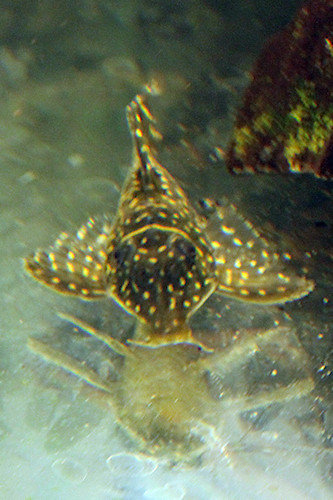Hybrids are bred from the pairing of two animals of different species. The mixing of different local varieties of one species is not better.
In General
In general we aquarists assume that different species of same genus can mate. For this, various hybrids on Loricariids especially in the genus Hypancistrus.

Hybrid from Hypancistrus sp. “L 260” and Hypancistrus zebra (L 46)
Photo: Wolfgang Heinrichs (Thanks, Wolfgang.) (At the request of Wolfgang to note that it is no bred from him.)
We also know hybrids from other genus, f.e. from genus: Pseudacanthicus, Leporacanthicus, Panaqolus, Peckoltia and Ancistrus. Between species from different genera the formation of hybrids can not be excluded in principle, but it is a very large exception. In Loricariids I know only two such exceptions:
- Sturisomatichthys cf. leightoni x Farlowella sp.
- Pseudohemiodon thorectes x Crossoloricaria bahuaja
As has been found, pleco-hybrids are fertile, so they can themselves again breds, and can also be further hybridized.
The problem
Hybrids in the aquarium hobby can build new “types” that would so not created in nature. The today given biodiversity makes this unnecessary. Rather, hybridization leads to significant problems in the aquarium biodiversity:In addition there are ominous distributors, which sell the hybrids as less frequently catched plecos. Than the price of this plecos is higher as normaly. For example: A seller offered me hybrids from Hypancistrus sp. „L 66“ and Hypancistrus zebra (L 46)
as Hypancistrus sp. “L 173” for a lot of money.This is usually very difficult to detect. Sometimes it helps to take a look at the parents. But in the second, the third-generation of hybrids …? Imagine, you buy any expensive rare to conservation of species (breeding) animals. After laborious breed you will detect, that a different species must have been crossed?!The preservation of natural, regular types is more difficult, because fewer animals of this species are available. It is always problematic to really find animals exactly the same species. Natural species are constantly being replaced in the aquarium hobby in this way. That is not in the interests of responsible aquarist.
What to do?
To avoid so you should generally not hold two species of the same genus in an aquarium, when the animals are sexually mature and both sexes available.If for whatever reason hybrids have been created, they should these not breed further. Furthermore, these animals should be passed only with the correct name to trusted, reliable aquarists.
Known hybrids
Ancistrus dolichopterus (L 183) x Ancistrus sp. "Gelb-Schwarzauge-Schleier"Crossoloricaria bahuaja x Pseudohemiodon thorectesHypancistrus cf. debilittera "L 340" / "LDA 19" x Hypancistrus sp. "L 411"Hypancistrus sp. "L 28" x Hypancistrus debilittera (L 129)Hypancistrus sp. "L 28" x Hypancistrus cf. debilittera "L 340" / "LDA 19"Hypancistrus sp. "L 66" x Hypancistrus sp. "L 201"Hypancistrus sp. "L 66" x Hypancistrus sp. "L 333"Hypancistrus sp. "L 66" x Hypancistrus sp. "Gurupá"Hypancistrus sp. "L 136" / "LDA 6" x Hypancistrus sp. "L 333"Hypancistrus sp. "L 136" / "LDA 5" x Hypancistrus sp. "L 333"Hypancistrus sp. "L 136" x Hypancistrus sp. "L 411"Hypancistrus sp. "L 201" x Hypancistrus sp. "L 333"Hypancistrus sp. "L 260" x Hypancistrus sp. "L 333"Hypancistrus sp. "L 262" x Hypancistrus sp. "L 270" / "LDA 76"Hypancistrus sp. "L 333" x Hypancistrus sp. "L 400"Hypancistrus zebra (L 46) x Hypancistrus sp. "L 66"Hypancistrus zebra (L 46) x Hypancistrus sp. "L 260"Hypancistrus sp. aff. zebra "L 173" x Hypancistrus sp. "L 333"Leiarius marmoratus x Pseudoplatystoma corruscansLeiarius marmoratus x Pseudoplatystoma fasciatumLeiarius marmoratus x Pseudoplatystoma punctiferLeiarius marmoratus x Pseudoplatystoma reticulatumLeporacanthicus triactis (L 91) x Leporacanthicus sp. "L 314" / "LDA 56"Panaqolus sp. "L 2" x Panaqolus sp. "L 397"Peckoltia oligospila (L 6) x Peckoltia sp. "L 377" / "LDA 18"Phractocephalus hemioliopterus x Leiarius marmoratusPhractocephalus hemioliopterus x Pseudoplatystoma fasciatumPimelodus blochii x Pseudoplatystoma fasciatumPseudacanthicus cf. leopardus "L 114" / "LDA 7" x Pseudacanthicus leopardusPseudacanthicus cf. leopardus "L 114" / "LDA 7" x Pseudacanthicus sp. "L 320"Pseudacanthicus pirarara (L 25) x Pseudacanthicus sp. "L 97"Pseudacanthicus sp. "L 96" x Pseudacanthicus leopardusPseudacanthicus sp. "L 97" x Pseudacanthicus cf. hystrix "L 185"Pseudacanthicus sp. "L 97" x Pseudacanthicus leopardusPseudacanthicus sp. "L 97" x Pseudacanthicus cf. leopardus "L 427"Pseudacanthicus sp. "L 97" x Pseudacanthicus cf. spinosus "L 160"Pseudacanthicus cf. spinosus "L 160" x Pseudacanthicus cf. hystrix "L 185"Pseudacanthicus cf. spinosus "L 160" x Pseudacanthicus leopardusPseudoplatystoma corruscans x Pseudoplatystoma reticulatumRineloricaria sp. "Rot" x Hemiloricaria lanceolataSturisoma aureum x Sturisoma festivumSturisoma festivum x Sturisoma barbatumSturisomatichthys leightoni x Farlowella sp.

Hybrid from Peckoltia oligospila (L 6) and Peckoltia sp. “L 377/LDA 18”
Photo: Gerhard Kiefner

Hybrid from Hypancistrus sp. “L 28” and Hypancistrus sp. “L 340”

Hybrid from Ancistrus dolichopterus (L 183) and Ancistrus sp. “Gelb-Schwarzauge-Schleier”
Cover picture: Hybrid from Hypancistrus sp. “L 66” and Hypancistrus sp. “L 201”





